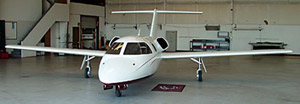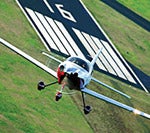 The Big Finish for 2005
The Big Finish for 2005
There’s excitement in the air in both Albuquerque, N.M., and Wichita, Kan. Final certification for the Eclipse 500 and the Cessna Mustang is almost in sight, and soon, all of us will get the first hints of just how deep the water is for the very light jet (VLJ) aircraft market. At the recent EAA AirVenture in Oshkosh, Wis., Eclipse flaunted two of its conforming prototypes, and Cessna debuted its Mustang, direct from Wichita, with CEO Jack Pelton at the controls. Both companies will close out this year with a hefty backlog of orders and expect to begin aircraft deliveries in 2006. For more information, contact Eclipse at (505) 245-7555 or log on to www.eclipseaviation.com, or Cessna at (800) 4-CESSNA or visit www.cessna.com.
 |
| Cessna Mustang |
 |
| Adam A700 |
 |
| HondaJet |
No matter which of the VLJs crosses the finish line first, one thing is certain: They won’t be alone for long. Adam Aircraft president Joe Walker says, “Go out five years from now, and what’s important is the fleet size, not the exact month the airplane first came to market.” His company is hard at work on the Adam A700, another contender for the VLJ category that expects a 2006 certification. For more information, call Adam at (866) ADAM-AIR or log on to www.adamaircraft.com.
And the elusive HondaJet came out of hiding for a guest appearance at Oshkosh in August. The aluminum-wing six-seater has long been in low-key flight testing, with Honda denying any intentions to market the aircraft. The company maintains that the HondaJet is merely a test bed for a cooperative engine-development venture between the Japanese car maker and General Electric. Rival Japanese auto giant Toyota built and tested a small four-place single (powered by a derivative of a Lexus V8), but both car makers are mum about entering the aircraft sales business. For more info, contact Honda Aircraft Engines at http://world.honda.cm/ AircraftEngines.
Another VLJ is lining up for flight testing. Excel-Jet’s single-engine Sport-Jet is planned to use a Williams FJ33-4A for 1,500 pounds of thrust. Projected performance numbers give the Sport-Jet a 2,500-fpm rate of climb and a max cruise of 375 knots at its ceiling of 25,000 feet. The aircraft is the newest design from Bob Bornhofen, innovator of the experimental category Maverick TwinJet. For more information, contact Excel-Jet at (719) 495-7221 or log on to www.sport-jet.com.

The Sino Swearingen Aircraft Corporation’s SJ30-2 twin-engine bizjet is nearing final certification. After a number of delays and setbacks, the San Antonio, Texas, company received the FAA’s Type Inspection Authorization (TIA). The TIA is a major milestone that precedes final certification testing. The long-range, single-pilot SJ30-2 jet is expected to make .83 Mach (560 mph) and maintain a sea-level cabin all the way to FL410. For more information, contact Sino Swearingen Aircraft Corporation at (888) JET-SJ30 or log on to www.sj30jet.com.
 |
| Sino Swearingen SJ30-2 |
 |
| Diamond DA42 Twin Star |
 |
| Malibu Power & Propeller-modified Piper Malibu |
 |
| American Champion High Country Explorer |
 |
| Tiger |
 |
| Quest Kodiak |
Diamond Aircraft won United States certification of its impressive DA42 Twin Star. The all-composite, jet-fuel-burning four-seater has been shipping to European customers for months, but U.S. certification has lagged behind. Diamond expects to begin American deliveries before the year’s end.
The Diamond DA42 Twin Star comes standard with the Garmin G1000 glass panel and features two TAE Centurion diesel engines, which sip a miserly eight gallons an hour (both engines combined) at 60% power and 12 gph at 80% power. A second version of the DA42 Twin Star with Lycoming 100LL avgas engines is planned for release this month. For more information, call Diamond Aircraft at (519) 457-4021 or log on to www.diamondair.com to see what the company has to offer.
Malibu Goes Digital
Malibu Power & Propeller is developing a turbocharged FADEC-powered Piper Malibu. The test aircraft is turning in a 2,000-fpm rate of climb. The company uses a Hartzell three-blade composite propeller, and adding FADEC to the Continental TSIOF-550 produces more power on the upgraded six-seater. Setting optimal power and best economy mixture is reduced to merely pushing a button. Malibu Power & Propeller also is working on an improved electrical system with a dual buss, dual battery, dual alternator and emergency buss tie. Next on its list is to improve the Malibu’s alternate induction air box for icing flight and a single-lever power control to manage the engine and prop. Contact Malibu Power & Propeller at (612) 386-8214 or log on to www.malibumods.com for more information.
Car Gas Champ
American Champion Aircraft Corporation announced the certification of the new High Country Explorer. The 180 hp backcountry high-wing is a derivative of the Citabria and is certified to run on both 100LL and unleaded automobile gas, thanks to a brand-new engine from Superior Air Parts. Its four-cylinder Vantage Engine is the first that is certified to run on both types of fuel. The High Country Explorer has a fixed-pitch prop, lighter aluminum landing gear and vortex generators that help in delivering a 370-foot takeoff roll. Call American Champion at (262) 534-6315 or log on to www.amerchampionaircraft.com for more information.
Asian Tigers
Tiger Aircraft received certification from China for its AG-5B, opening the door for the snappy little four-seater to enter what many imagine as the next big general-aviation boomtown. Tiger is busy setting up a distribution network, the precursor for Tiger flight-training facilities in China. Current plans call for airframe manufacturing to remain in Martinsburg, W.Va. Contact Tiger at (877) 80-TIGER or log on to www.tigeraircraft.com for more info.
The Quest Is Near
The Kodiak, a 10-place, single-engine turboprop, is pushing 300 hours of test flight out of its Sandpoint, Idaho, birthplace. With a projected price tag of $1.1 million, Quest Aircraft expects certification of the Kodiak in early 2006. Call Quest Aircraft at (208) 263-1111 or log on to www.questaircraft.com for more info.
 Cirrus Adds TAWS And PWAS
Cirrus Adds TAWS And PWAS
Cirrus Design announced the terrain awareness and warning system as a standard feature in its new Avidyne Entegra-equipped SR20s and SR22s. The system uses a GPS database to provide both a visual and aural alarm of danger for flights anywhere in the world. TAWS is a major deterrent against controlled flight into terrain accidents, a leading cause of in-flight mishaps. Retrofitting is available for older Cirrus models.
The Duluth, Minn., manufacturer also recently celebrated the completion of its 2,000th aircraft. At Oshkosh this year, Dale Klapmeier announced that milestone aircraft will be flown by air-show legend Patty Wagstaff.
“I’m really excited about my new relationship with Cirrus,” says Wagstaff. “After my first flight in an SR22, I realized that this company is committed to designing airplanes for a new generation of pilots.”
Her professional entity, Patty Wagstaff Air Shows, will use the aircraft to travel the country back and forth from engagements, not in aerobatic competition. Wagstaff is a three-time U.S. National Aerobatic Champion and six-time U.S. Aerobatic Team member. Her aerobatic Extra 260 now hangs in the Smithsonian. The newer Extra 300 she currently flies will feature the Cirrus name on top and bottom. For more, contact Cirrus at (218) 727-2737 or log on to www.cirrusdesign.com.
 Lancair By Any Other Name
Lancair By Any Other Name
Citing confusion over the Lancair Kit Planes and the Lancair Certified Aircraft divisions, the latter half of the Bend, Ore., company will now be known as Columbia Aircraft Manufacturing (CAM). The Columbia 350 and turbocharged 400, one of the fastest production pistons in the world, will continue down the same production line, but now roll out from the newly named CAM division.
New Columbias will soon feature a de-ice system called E-Vade. The $25,000 option should be shipping before the end of the year, and retrofits are in the works for older Columbias. CAM expects to build 175 airplanes in 2005 and 230 next year. A new 18-wheel truck is now touring airports across the country to promote the new high-performance composite aircraft. For more, call CAM at (541) 318-1144 or log on to the company’s Website at www.flycolumbia.com.
 Damned Big Rotax
Damned Big RotaxTwo years ago, aerospace giant Bomb ardier announced a V-6 FADEC-controlled, water-cooled engine, but soon afterward, the jungle drums went quiet. Now, the engine is alive and well, being marketed by a new company called Aircraft Engine Services. The new engine, actually engines—a 220 hp and a 300 hp model—are manufactured by Rotax, wholly owned by Bombardier. Contact Aircraft Engine Services at (321) 268-3718 or log on to www.vaircraft engine.com.
Never Too Late
Three NASA test pilots who flew the famed X-15 rocket plane were finally awarded their astronaut wings. The X-15’s nine-year test programs saw a number of flights above 328,000 feet, the internationally accepted boundary for space. The X-15 Air Force pilots received astronaut wings, but the NASA pilots didn’t. The oversight was rectified at the NASA Dryden ceremony last August.
Another NASA recognition arrived. Guinness World Records now lists NASA’s experimental X-43A scramjet as holding the new world speed record. It reached Mach 9.6 on a test flight over the Pacific. Call NASA’s Dryden Flight Research Center at (661) 276-3449 or log on to www.nasa.gov.
Record High And Low
Meantime, Carter Aviation Technologies announced it has broken the Mu-1 barrier, an aerodynamic ratio of the forward speed of an aircraft to the tip speed of its rotor that was previously thought to be unbreakable. The unplanned record-breaking accomplishment took place during a test fight. The CarterCopter pushed through Mu-1 flight for 1.5 seconds, with initial data indicating that the airspeed was 170 mph and the rotor at 107 rpm—a Mu value of 1.02. If the company data is correct, this was the first time in history the Mu barrier has ever been broken.
Shortly after the milestone achievement, however, the nose pitched down and the CarterCopter began a left roll. Test pilots Larry Neal and Brad King were able to regain some pitch control before hitting trees. Both pilots were uninjured, but the one-of-a-kind helicopter was destroyed. Nevertheless, CarterCopter has posted data from the record-breaking flight on its Website. Contact Carter Aviation Technologies at [email protected] or visit www.cartercopters.com.




